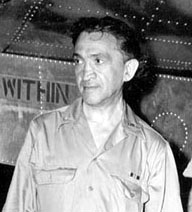William Laurence
| William Leonard Laurence | |
|---|---|

Laurence on the island of Tinian before the atomic bombings of Hiroshima and Nagasaki.
|
|
| Born |
Leib Wolf Siew March 7, 1888 Salantai, Lithuania (then Russian Empire) |
| Died | March 19, 1977 (aged 89) Majorca, Spain |
| Citizenship | United States (naturalized 1913) |
| Employer | The New York Times |
William Leonard Laurence (March 7, 1888 – March 19, 1977) was a Jewish Lithuanian-born American journalist known for his science journalism writing of the 1940s and 1950s while working for The New York Times. He won two Pulitzer Prizes and, as the official historian of the Manhattan Project, was the only journalist to witness the Trinity test and the atomic bombing of Nagasaki. He is credited with coining the iconic term "Atomic Age" which became popular in the 1950s.
Laurence was born Leib Wolf Siew in Salantai, a small city in the Russian Empire that is now in Lithuania. He emigrated to the United States in 1905, after participating in the Russian Revolution of 1905, and he soon changed his name, taking "William" after William Shakespeare, "Leonard" after Leonardo da Vinci, and "Lawrence" after a street he lived on in Roxbury, Massachusetts (but spelled with a "u" in reference to Friedrich Schiller's Laura). He attended college at Harvard University, Harvard Law School, and Boston University, and became a naturalized United States citizen in 1913. During World War I, he served with the U.S. Army Signal Corps, and in 1919 attended the University of Besançon in France.
In 1926 he began his career as a journalist, working for The World of New York City. In 1930 he began working at The New York Times, specializing where possible in reporting on scientific issues. He married Florence Davidow in 1931.
...
Wikipedia
